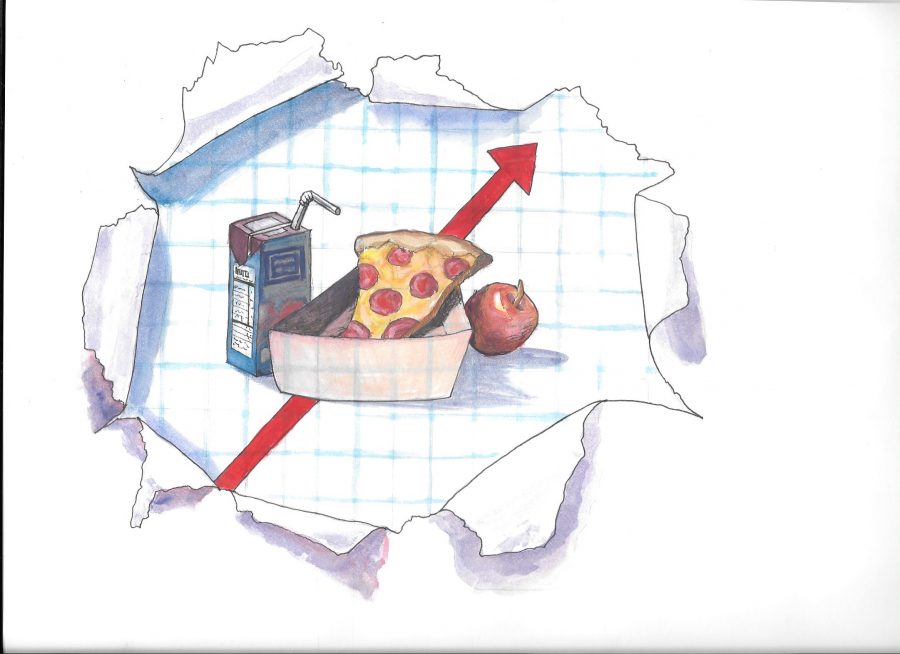Little praise for the price raise that aids (the district)
November 30, 2016
In the 2015-16 school year, Dougherty Valley High School’s lunch prices, along with those of all San Ramon Valley Unified School District high schools, rose from $4.00 to $4.75 with no change in content.
The unanimous school board decision in June 2015 marked the first price raise in seven years and sparked discord between the district and students over the quality and price of lunches.
Several students, such as senior Tiffany Yim, have argued that the price of lunches has a larger cumulative total than many assume: “If we consider an eight-month school year [at the old price] and a student buys lunch every single day, that’s about $760. Considering a student that buys lunch every day for all four years of high school, that’s a whopping $3,040.”
With the added price raise, and the assumption of a 36-week school year, there is a total increase of $135 per year.
Freshman Katie Moore said “most people can’t afford a $5 lunch five days a week for 12 school years.”
Among students who can afford the new price, there is discontent, as well.
Junior Brandon Wang, who buys lunch regularly at full price, states, “The new price has not affected me financially, but it makes me regret buying anything more than necessary … Lunch prices should really be about $2.50 or less.”
The San Ramon district is not unique in increasing lunch prices: Both the Dublin Unified School District and the Pleasanton Unified School District have increased lunch prices in the past three years. Dublin’s high school lunch prices have gone up from $3.50 in the 2014-15 school year to $4.25 in the 2015-16 school year to a two-tiered system with prices of $4.25 and $5.00 in which people can choose a “premium” food option or the normal lunch. Meanwhile, Pleasanton raised their high school lunch prices from $3.50 to $4.00.
Several things are constant throughout the three districts. California mandates that lunch prices for adults be at least 50 cents more than the price for students, even when the content is unchanged. In addition, free and reduced-price options do not affect the overall price of lunch. (All the districts are a part of the National School Lunch Program, which offers larger subsidies for free or reduced lunches than for regularly priced lunches. The San Ramon Valley, Dublin and Pleasanton districts have low percentages of students with these financial needs.)
All three districts have stated that the main reason behind the price hikes is that their Child Nutrition departments are self-funded, aside from National School Lunch subsidies that account for 13 percent to 15 percent of revenue in the San Ramon Valley district, according to Child Nutrition Director Bruce Hall, and about 10 percent of revenue in Dublin, according to Dublin Child Nutrition Director Frank Castro. This means that the food, equipment and labor costs of the Child Nutrition departments must come from food sales. Thus, when any of these costs rise, the districts need to raise lunch prices to remain solvent.
More specifically, San Ramon Valley’s increased labor costs, increased food costs, and a deficit in the food department have caused the price hike. Hall states that every year, the union re-negotiates wages, partially to adjust to the steadily rising cost of living in the Bay Area; thus labor costs have been increasing. Like with labor costs, Hall notes, the price of food simply increases each year. Part of this is likely due to California’s drought: increased groundwater scarcity also causes the production costs of many foods rise, and thus the price, according to the United States Department of Agriculture Economic Research Service.
Hall, along with the school board, believes that the price raise was imperative because these costs put the Child Nutrition department into deficit when lunches were at $4. The Child Nutrition department has never made a profit, and though “the department is to run like a business with the intent of operating a positive ending balance … any child nutrition department is not able to have any more than three months of revenue in reserves without having to come up with a spending plan to spend down the excess in their account.” The price hike was seen as insignificant enough to students, but also sufficient to fund the department.
A number of students report that the price hike has had minimal economic effects, but there is another source of student dissatisfaction: the alleged disproportional quality and quantity of food for the price.
Freshman Nicholas de Leon argues that “if the lunch prices are increasing, the food should be better. Sometimes the rice isn’t even cooked and … there should be larger meals,” de Leon stated.
Sophomore Stephanie Swee agrees: “For this price of lunch, the portions are incredibly small and taste bad … The quality of the food is almost inedible, like the brown rice.”
Dublin’s prices have also risen solely due to increased food and labor costs, meaning they haven’t faced a major program deficit. In fact, Dublin has been able to use money from lunch sales to purchase better equipment for the department. Recently, they have been able to purchase a food truck. Castro also said that part of the price hike included better quantities and quality of food. They currently offer a premium option.
But Dublin has open campus lunch, which affects the costs and revenues of the Child Nutrition department. While Dublin serves around 450 lunches per day, San Ramon Valley serves 6,200 to 7,000 meals, leading to higher expenses. Compared to Dublin’s 39 and Pleasanton’s 65 Child Nutrition employees, the San Ramon Valley district hires 150 permanent and 20 to 25 substitute employees for its Child Nutrition department, explaining the San Ramon Valley’s deficit and Dublin’s surplus.
Even in the face of student opposition, the price hike has done its job: to help reduce the amount that the Child Nutrition department encroaches on the Ed Fund. It is Hall’s hope that the new prices will allow the department to break even.



